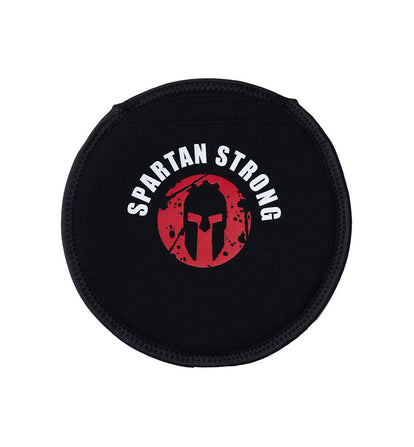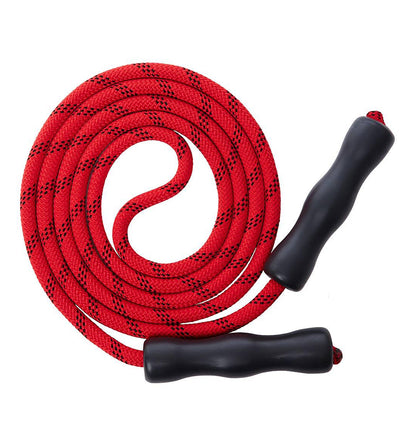Training for OCR? Get Battle-Ready with These Home-Gym Must Haves

In my last article, I went over some of the basic fitness equipment that everyone should have in their home gym—regardless of what they’re training for.
You might be ready for more than just the basics though. You may, in fact, be training for a Spartan race. In that case, you’ll want to start training not just for general fitness, but with Spartan’s signature obstacles in mind. Here’s the gear you’ll need to train to tackle even the hardest obstacles out on the course.
Ready to commit to your first Spartan race or returning to the course looking to set a new personal record? Commit now!
Training Equipment for Obstacle Racing: Here's What You Need ASAP
1. Spartan Strong Pancake Sandbag
This is probably the single best tool for grip training ever invented—as good as rock climbing, except it’s something you can use in your own home, every day.
Shaped like, well, a fattened pancake, the Spartan Strong Pancake Sandbag is designed to be gripped around the edges. This means your grip is always tenuous at best, and you’re holding the edge of the sandbag only loosely in your palms. In other words, you rely much more heavily on your fingers than you would when gripping a kettlebell or medicine ball to train your grip strength.
The exercises you’ll use it for are largely the same low-speed exercises you’d do with a kettlebell or (occasionally) a medicine ball—Romanian deadlifts, snatches, ab twists, and so on.
Related: 4 DIY OCR Tools to Amp Up Your At-Home Gym
The pancake is not suitable for high-speed exercises like kettlebell swings—it would most likely fly out of your hands, and in any case, it makes little sense to try and train your grip explosively. For that you’ll want a Spartan Slam Ball, as discussed in my article on home gym fundamentals.
Instead, think of it as a way to perform the aforementioned low-speed exercises in a way that places extra workload on the gripping muscles of your hands and forearms, building an iron grip to prepare you for obstacles like Olympus or The Twister.
As for how to incorporate the pancake into your training, be aware that exhausting your grip strength early in a workout can hinder you for any subsequent exercises—as such, save grip work for the end of a workout.
An alternative strategy that tends to work well for grip-dominant exercises is grease the groove training—doing a set every 15+ minutes throughout the day, stopping each one well short of failure. This allows you to get a very high volume of training in with minimal fatigue, and avoids disrupting your usual workouts by separating out your grip training.
2. Heavy Jump Rope
The Spartan Heavy Jump Rope is the same nine feet in length as the regular jump rope. Whereas the Spartan Jump Rope weighs 13.5 oz however, the Spartan Heavy Jump Rope weighs 3.25 pounds—nearly four times as much.
The extra weight transforms jump-roping from a pure cardio exercise to a mixed cardio and muscular endurance exercise. It trains the entire arm-shoulder-upper back complex, particularly the forearms and shoulders. Continued use not only builds stamina and muscular endurance, but also trains economy of motion—you learn to keep the rope moving without moving your muscles more than you have to.
The heavy jump rope is a great training tool for any activity that requires continuous full-body movement. That includes many of Spartan’s climbing obstacles, such as the Spartan Ladder or Tyrolean Traverse.
3. Battle Rope and Climbing Rope
The Spartan Rugged Battle Rope is 30 feet long, 1.5 inches thick, and weighs 14.5 pounds. To put it mildly, this is no jump rope. The battle rope has two distinct uses.
The first is to replicate some of Spartan’s obstacles in your home gym. Hang one of these ropes from a bridge, ceiling, tree in the park, or pull-up bar and you can practice the rope climb. Attach it to a pulley and you have the Hercules Hoist.
The other use—and admittedly, the easier one in terms of set-up—is to use it as a standalone training tool for upper body strength-endurance. In this modality, it’s a good tool for training for climbing exercises that solely or predominantly utilize the upper body, such as the monkey bars, ape hanger, or multi-rig.
If you’re not familiar with battle-roping, this video shows 45—yes, forty-five—battle rope exercises. As you can see, the battle rope can be turned into more of a full-body tool by incorporating hops, lunges, and yes, even burpees into your battle-roping.
As a final note, the battle rope is also included in the Spartan Bucket Training Kit, which is available in both men’s and women’s versions—they have the same contents, but different resistance levels for the included resistance bands.
Related: 5 Workouts for Rope Climb Success
4. Spartan Cooling Towel
Look, obviously you want a towel. Towels are good to have. You probably have one already.
The Spartan Cooling Towel is special though. High-tech. (No, not like Towelie from South Park.) Rather than normal cloth, it’s made with PVA (polyvinyl acetate) and coated with antibacterial material.
What’s interesting about PVA is, it will absorb a little bit of water, but not enough to get waaaay heavy, and it won’t absorb dirt. Once the water is absorbed, it leaks out only very slowly, cooling in the process.
On top of that, the towel is full of little holes, which allow airflow to cool the towel—and your body underneath it. There’s also a larger hole so you can stick the towel around your neck, like a superhero cape that cools you down.
In short, this thing is designed to be the perfect towel for using during—not just after—a race or a long workout. All you have to do is get it wet, wave it a bit to lose any excess water and cool it with airflow, and throw it around your neck. For the next hour or so, it will stay cool and moist thanks to the airflow from your own movement.
As strange is it may sound, this towel is probably the most high-tech thing Spartan has ever made. An hour into your first OCR event, you’ll be very glad to have it.










